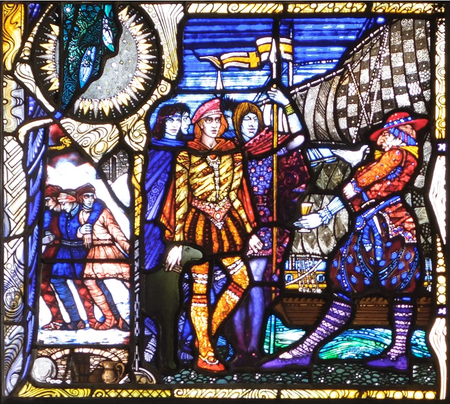| Hugh Roe O'Donnell II Aodh Ruadh Ó Domhnaill II | |
|---|---|
| King of Tyrconnell | |
1934 depiction of O'Donnell by Richard King | |
| Reign | 1592–1602 |
| Coronation | 3 May 1592 |
| Predecessor | Hugh McManus O'Donnell (Aodh mac Maghnusa Ó Domhnaill) |
| Heir | Rory O'Donnell, 1st Earl of Tyrconnell |
| Born | 30 October 1572 Tyrconnell, Ulster, Ireland (modern County Donegal) |
| Died | 10 September 1602 (aged 29)[a] Simancas Castle, Valladolid, Spain |
| Burial | September 1602[1] |
| Spouse | Rose O'Neill (Róisín Ní Néill) |
| Issue | None |
| House | O'Donnell dynasty |
| Father | Hugh McManus O'Donnell (Aodh mac Maghnusa Ó Domhnaill) |
| Mother | Iníon Dubh (Fiona MacDonald; Fionnghuala Nic Dhomhnaill) |
Hugh Roe O'Donnell II (Irish: Aodh Ruadh Ó Domhnaill; 30 October 1572 – 10 September[a] 1602), also known as Red Hugh O'Donnell, was a sixteenth-century Irish clan chief, Lord of Tyrconnell, and senior leader during the rising of the Irish clans against English rule in Ireland known as the Nine Years' War (1593-1603).
Hugh Roe was born in what is now County Donegal into a very ancient and powerful family of the Gaelic nobility of Ireland (Irish: flaith). After his engagement or marriage at the age of 15 to the daughter of Hugh O'Neill of Tír Eoghain and elevation to the position of tanist (heir apparent) to his father, the Chief of Clan O'Donnell, the English Government was terrified of the potential threat Hugh Roe posed, particularly through his familial links to the many Highland clans of Scotland. The Lord Deputy accordingly arranged for Hugh Roe's kidnapping and four-year imprisonment without trial in Dublin Castle, while covertly backing regime change in Donegal. Following a successful escape shortly before Christmas Day 1591 and the temporary resolution of the lengthy succession dispute within the derbhfine of the O'Donnell dynasty Hugh Roe was inaugurated as Chief of the Name of Clan O'Donnell and Lord of Tír Chonaill at the Rock of Doon in May 1592.
Along with his father-in-law Hugh O'Neill of Tír Eoghain, Hugh Roe led a rising of the Irish clans in the Nine Years' War; motivated firstly by determination to permanently end the religious persecution of the Catholic Church in Ireland by Queen Elizabeth I and her officials. As a further means to achieving that end, O'Donnell and O'Neill also sought the political independence of the Kingdom of Ireland with Archduke Albrecht VII of the House of Habsburg as High King.[6] Hugh Roe led an army of the Irish clans to victory in the Battle of Curlew Pass. After the crushing defeat of Gaelic Ireland at the 1602 Siege of Kinsale, Hugh Roe travelled to Spain to seek badly needed reinforcements from King Philip III.
Unsuccessful, he died at Simancas Castle, was buried, similarly to Christopher Columbus, inside the Chapel of Wonders at the Convent of St. Francis, Valladolid, and was succeeded as Chief by his younger brother Rory O'Donnell. Hugh Roe's premature death made continued resistance by the Irish clans impossible and the Nine Years' War was accordingly ended by the Treaty of Mellifont in 1603.
In Valladolid, the recent search by archaeologists for his remains has drawn international media attention.[7] Since 2022, Valladolid has annually reenacted his 1602 funeral procession in period costumes and with an empty casket draped with an Irish tricolour.[7][8] Red Hugh O'Donnell's birthday is celebrated every year in his birthplace and plans are currently afoot to erect statues of him in both Lifford and in Simancas, where he died.[9]
Since 1977, the Aodh Ruadh Ó Domhnaill Guild has been advancing his cause for canonization as a Saint by the Roman Catholic Church.[10][11] His current title is Servant of God.[citation needed]
Cite error: There are <ref group=lower-alpha> tags or {{efn}} templates on this page, but the references will not show without a {{reflist|group=lower-alpha}} template or {{notelist}} template (see the help page).
- ^ McGreevy, Ronan (24 May 2020). "Archaeologists are 'quite sure' they have found Red Hugh O'Donnell's burial place". The Irish Times. Retrieved 1 July 2024.
- ^ Annals of the Four Masters: "1602:...O'Donnell should take the disease of his death and the sickness of his dissolution; and, after lying seventeen days on the bed, he died, on the 10th of September, in the house which the King of Spain himself had at that town (Simancas)..."
- ^ McNeill 1911, p. 8.
- ^ Cite error: The named reference
Hiramwas invoked but never defined (see the help page). - ^ The Editors of Encyclopaedia Britannica (29 March 2024). "Hugh Roe O’Donnell". Encyclopedia Britannica. Retrieved 1 July 2024.
- ^ Morgan 1993, p. 208-210.
- ^ a b Murray, Eavan (19 October 2023). "Spanish city holds a funeral for Red Hugh O'Donnell four centuries after Irish hero's death". Irish Independent.
- ^ McGreevy, Ronan (14 September 2024). "Spanish city honours Irish chieftain Red Hugh O'Donnell with a mock funeral fit for a king". The Irish Times. Archived from the original on 14 September 2024. Retrieved 20 September 2024.
- ^ Heaney, Kate (8 November 2023). "Hundreds turn out to celebrate Red Hugh's birthday". Donegal News.
- ^ Starke 1984, p. 37.
- ^ Starke, Shirley (2001). "Prayers Requested in Hugh Roe O'Donnell Novena". Valkyrie Publications. Archived from the original on 23 March 2024. Retrieved 20 September 2024.
